Introduction
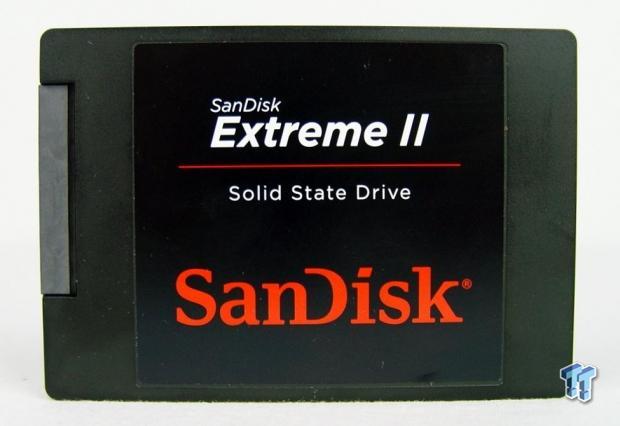
Today is a big day for SanDisk. We've already published an article that covers the Extreme II architecture and a full review of the 120GB capacity size drive. So far, so good - SanDisk's new enterprise SSD is a solid performer in what we're published already, but the easy test is now over, it's time to step into the big boy ring.
The 120GB capacity size was easy for SanDisk to steam roll competitor's products since SanDisk has the most advanced flash in a consumer SSDs on the market today. The 256GB class is another story though, more interleaving of the NAND and several products still around with 24nm/25nm means this capacity size is more street brawl than boxing match.
SanDisk's original Extreme is one of the big players in the 256GB class and its new $160 price point is amazing for such a good product. If I would have seen the price at Amazon, it would have won the Bang for your Buck - The Best 256GB Class SSDs under $200 award a few weeks ago. At the time the drive wasn't at Newegg, which I used to compare prices. In the same boat at OCZ's Vector, the Extreme uses older 2xnm flash and we know production has either stopped or been reduced. Extreme won't be around much longer at $160 or any price.
Enter SanDisk's new flagship SSD, Extreme II. Based on the latest Marvell 88SS9187, the same used in the Plextor M5 Pro / Xtreme and Crucial M500, the controller already has a solid reputation for stability, performance and the ability to scale to 1TB with new 128-bit NAND flash. The 9187 isn't a plug and play controller like the LSI SandForce SF-2281. If a company wants to use it, they need to either write firmware or hire an outside firm to do it. Working with a third-party means delays in the optimization cycle, because of that SanDisk is now building their own firmware, working on their own optimizations and promises to not have another TRIM event ever again.
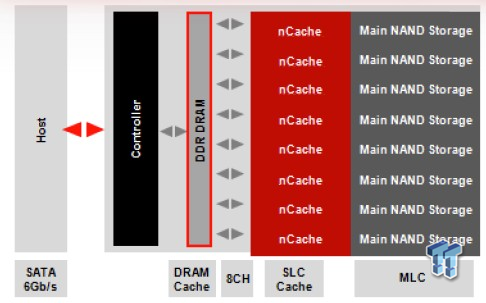
Having their own in-house firmware team also means the secret sauce doesn't need to leave the company HQ. First introduced on the mainstream Ultra Plus SSD, SanDisk's eX2 ABL 19nm flash for the Extreme II features a fairly unique technology called nCache. We covered nCache in detail in out Extreme II Introduction article (linked above) earlier today and it's worth the read if you like knowing all of the little tech details. If you just want to read about the performance, read on!
Specifications, Pricing and Availability
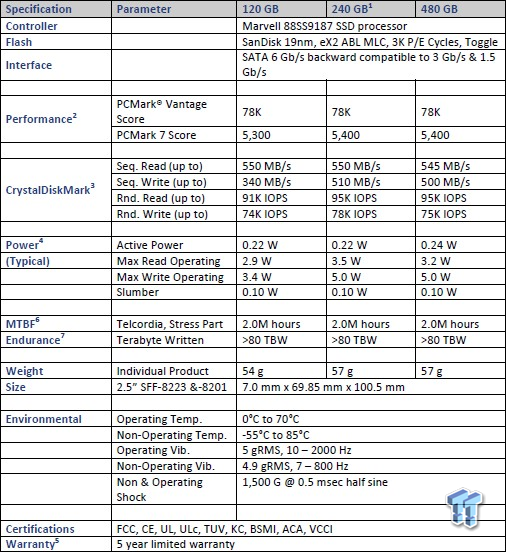
The SanDisk Extreme II starts shipping today and in three capacity sizes - 120GB, 240GB and 480GB. Many of us would love to see a 960GB version, but SanDisk chose to leave a massive capacity size model off the table, at least for now. At the heart of Extreme II is a Marvell 88SS9187 controller with custom SanDisk firmware. Paired with the 9187 is SanDisk 19nm MLC Toggle flash rated for 3K P/E cycles.
In a move designed to set a new standard, or to rebut the old ways, SanDisk used CrystalDiskMark to determine the marketing performance numbers. For years, ATTO and IOMeter were used to come up with marketing performance results, but over time, companies moved away from the default ATTO tests (QD4) and IOMeter can be manipulated with compressible or incompressible results. To stop any confusion, SanDisk chose to use CDM for their marketing materials since it's easy to run and a free application.
With that explanation out of the way, let's look at the specs. The 240GB Extreme II delivers 550MB/s sequential read performance and 510MB/s sequential write performance. IOPS performance comes in at 95K read and 75K write. The 240GB capacity size is the fastest in the Extreme II product family.
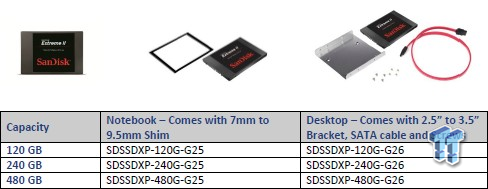
Each capacity size ships in two flavors, a Notebook version with a 7mm to 9.5mm adapter and a full Desktop Upgrade Kit with a desktop adapter bracket, SATA cable and mounting screws. Extreme II also has a five year warranty.
Just days before going live with the reviews, we received word about pricing. SanDisk's MSRP for the 120GB Extreme II is $129.99, 240GB is $229.99 and the 480GB is $439.99.
SanDisk Extreme II 240GB
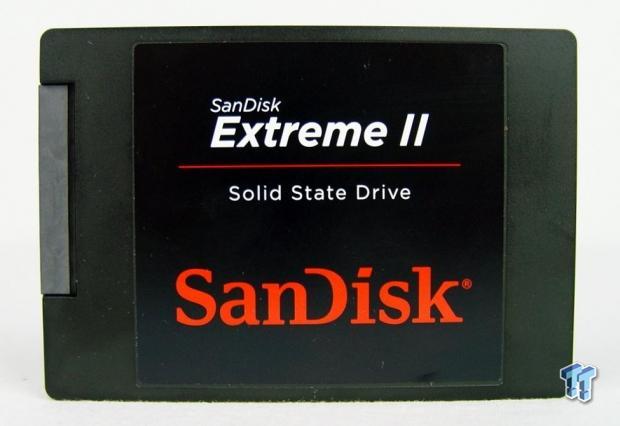
SanDisk delivered three drives, one of each capacity size, but we didn't receive the retail package to show today. We don't expect much of a change from the Ultra Plus or original Extreme. This is a 7mm z-height product with a metal base and a plastic top cover.
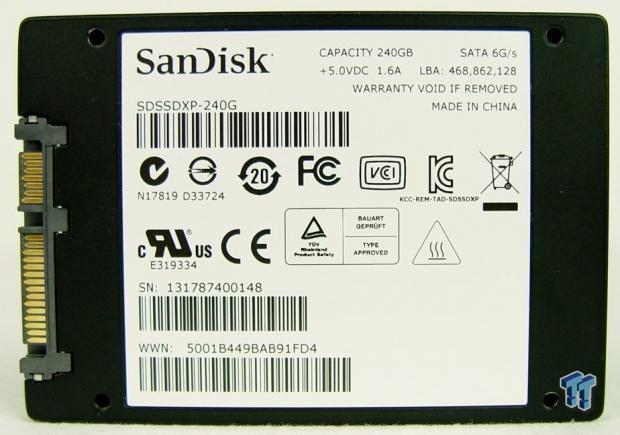
The capacity size, model and serial number are all located on the back of the drive.

The 7mm z-height, 2.5" form factor uses the same mounting points on the bottom and sides as traditional notebook drives that are 9.5mm tall.
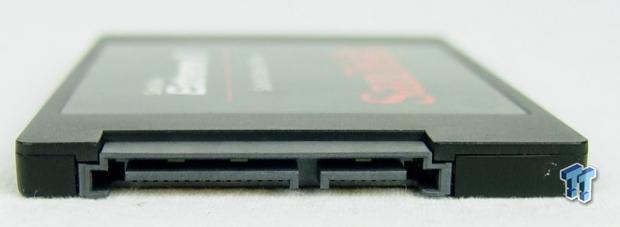
The SATA power and data connectors are also the same as standard notebook drives. The Extreme II will fit in your notebook and many ultrabooks without issue. Desktop users can purchase the Desktop Replacement Kit and receive a desktop adapter bracket that puts the drive in a standard 3.5" HDD bay.
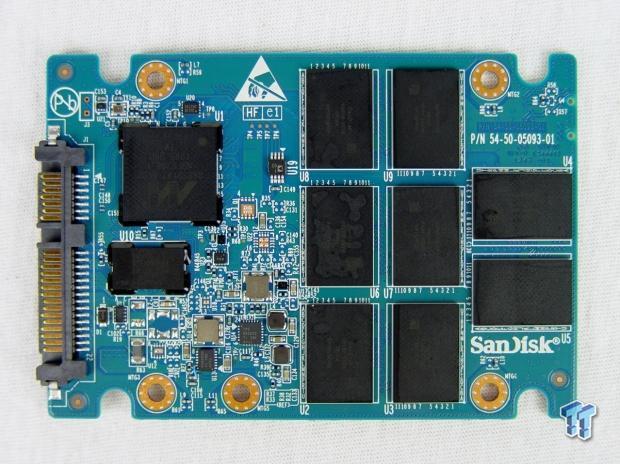
Here we get our first real shot of the SanDisk Extreme II. Unlike the 120GB model, the 240GB and 480GB populate all eight of the flash pads. Each NAND chip, the controller and the DRAM module all get a thermal pad to help transfer heat to the 7mm metal housing.
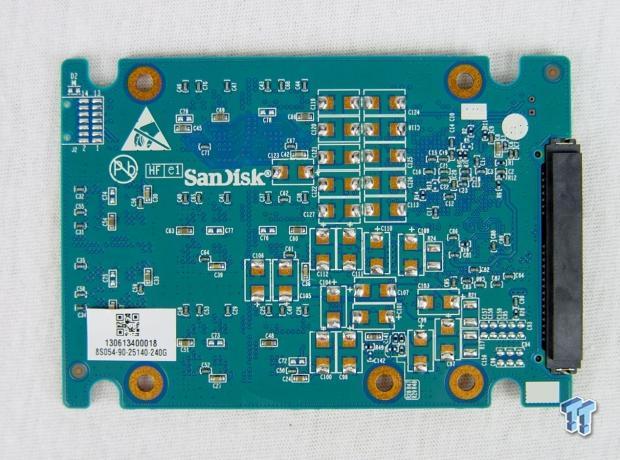
Extreme II has many open pads on the back for large surface mount capacitors. These aren't used on Extreme II so we can't help but wonder what other products SanDisk has cooking in the lab with this PCB.
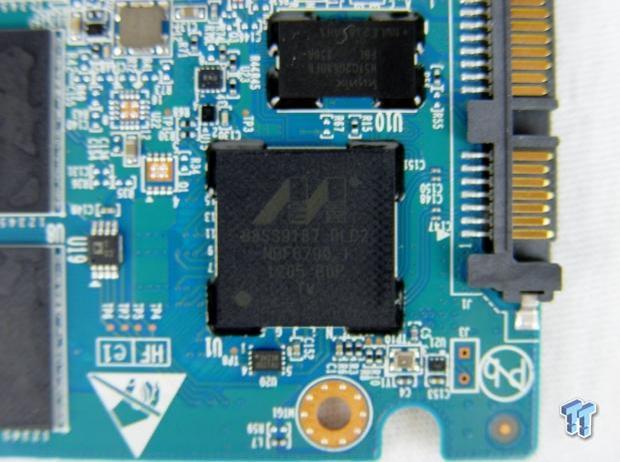
As we mentioned in the introduction, the Extreme II uses the Marvell 88SS9187 controller. This is an 8-channel design, the same used Plextor's M5 Pro and M5 Xtreme as well as Crucial's M500. It's a solid controller known for high performance when paired with quality NAND and well written firmware.
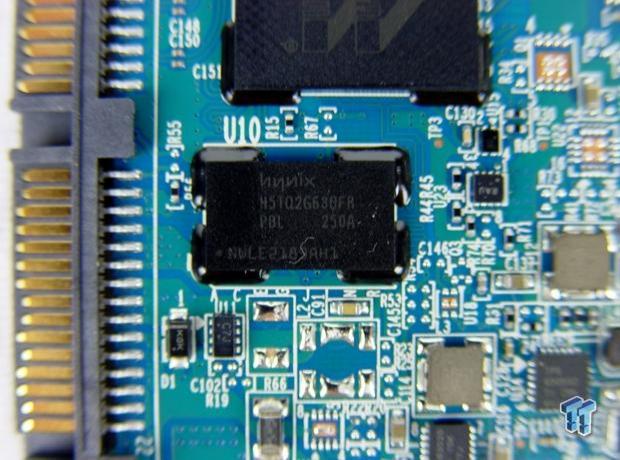
The 240GB size is the only model of the three we have on hand to use Hynix DRAM. The 120GB and 480GB both use Samsung DRAM. The Hynix part number refers to a DDR3 DRAM module with 2GB capacity size, double that of the 120GB Extreme II size.
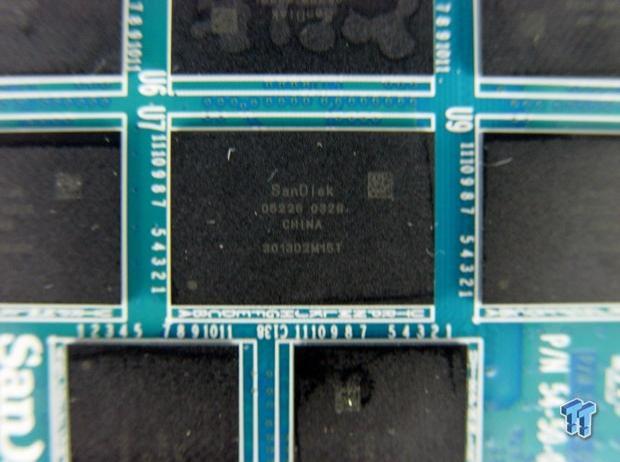
In the 120GB Extreme II review we talked about the SanDisk NAND quite a bit. In the 256GB class size, the flash has more interleaving, so SanDisk's architecture advantage shouldn't stand out as much. Let's dive right in and see how that theory works out.
Benchmarks - Test System Setup and ATTO Baseline Performance
Desktop Test System
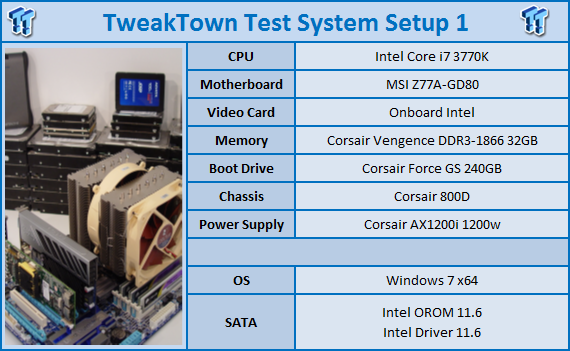
Lenovo W530 - Mobile Workstation
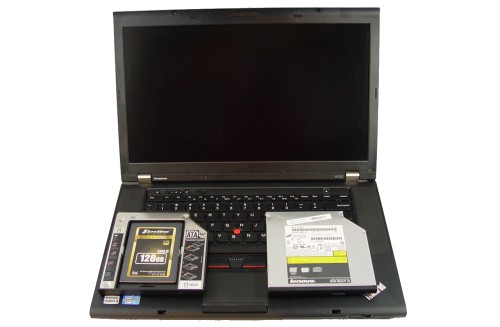
We use two systems for SSD testing. The desktop runs a majority of the tests and the Lenovo W530 runs the notebook power tests as well as the real-world file transfer benchmark.
ATTO Baseline Performance
Version and / or Patch Used: 2.34
ATTO is used by many disk manufacturers to determine the read and write speeds that will be presented to customers.
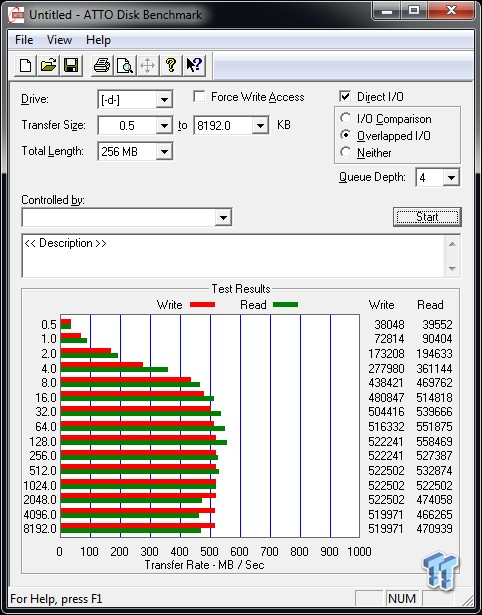
In ATTO we see a different performance profile than what we normally see with SSDs. The highest performance is no longer in the largest block size. This is true for both reads and writes. We suspect SanDisk's nCache play a role is shaping the curve. As we mentioned on the specifications page, SanDisk moved to CDM for their marketing number, this new curve could have played a role in that decision.
We found the best read performance at the 128K block size, nearly 560MB/s. The write performance reached its highest mark in three block sizes, 512, 1024 and 2048, all at nearly 523MB/s.
Benchmarks - Sequential Performance
HD Tune Pro
Version and / or Patch Used: 4.00
Developer Homepage: http://www.efdsoftware.com
Product Homepage: http://www.hdtune.com
HD Tune is a Hard Disk utility which has the following functions:
Benchmark: measures the performance
Info: shows detailed information
Health: checks the health status by using SMART
Error Scan: scans the surface for errors
Temperature display
HD Tune Pro gives us accurate read, write and access time results and for the last couple of years has gained popularity amongst reviewers. It is now considered a must have application for storage device testing.
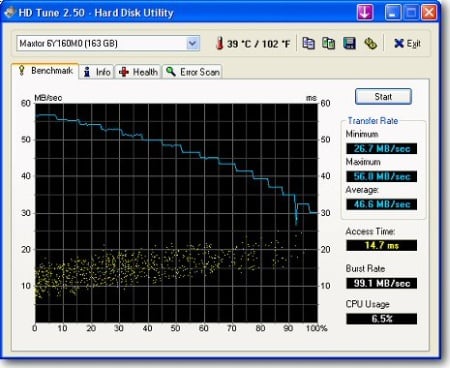
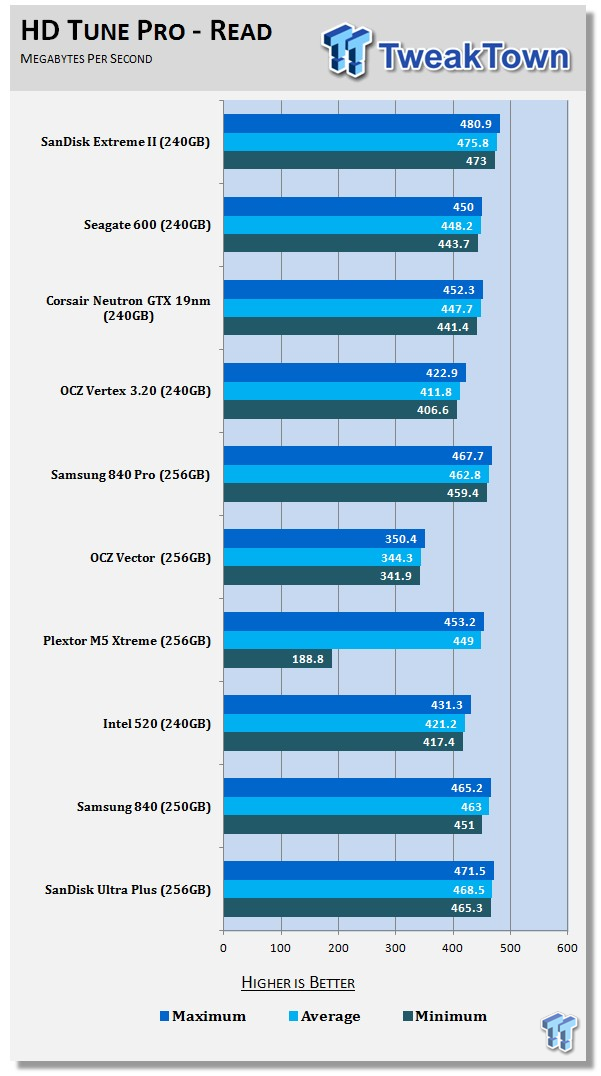
The SanDisk Extreme II hits a home run with its first time at bat. The average sequential read performance across the drive is a chart topping 475.8MB/s.
Someone wake up Samsung and OCZ, SanDisk just crashed the hyper-performance party!

The SanDisk Extreme II is a switch hitter; it can swing the bat writing sequential data across the drive, too. The 441MB/s write average in HD Tune Pro is also higher than Samsung's 840 Pro.
HD Tach - Sequential Write Performance after Random Writes
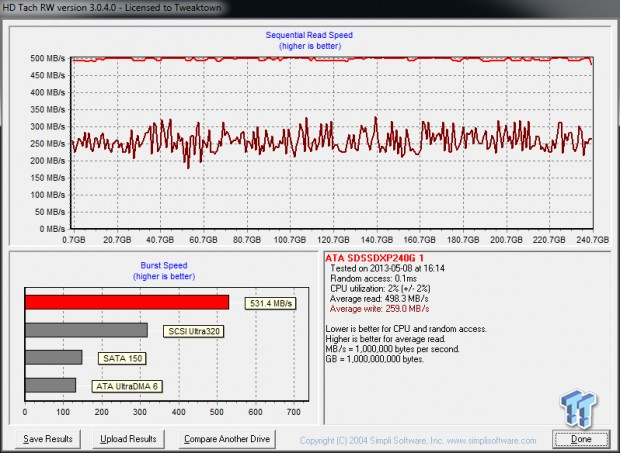
The sequential write performance dips down after a realistic and controlled amount of random writes to the flash. Extreme II has a built-in garbage collection engine so over time the write performance will increase to fresh out of box states.
Benchmarks - AIDA64 Random Access Time
AIDA64 Random Access Time
Version and / or Patch Used: 1.60
Developer Homepage: http://www.aida64.com
Product Homepage: http://www.aida64.com
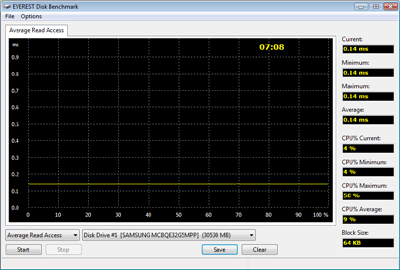
AIDA64 offers several different benchmarks for testing and optimizing your system or network. The Random Access test is one of very few if not only that will measure hard drives random access times in hundredths of milliseconds as oppose to tens of milliseconds.
Drives with only one or two tests displayed in the write test mean that they have failed the test and their Maximum and possibly their Average Scores were very high after the cache fills. This usually happens only with controllers manufactured by Jmicron.
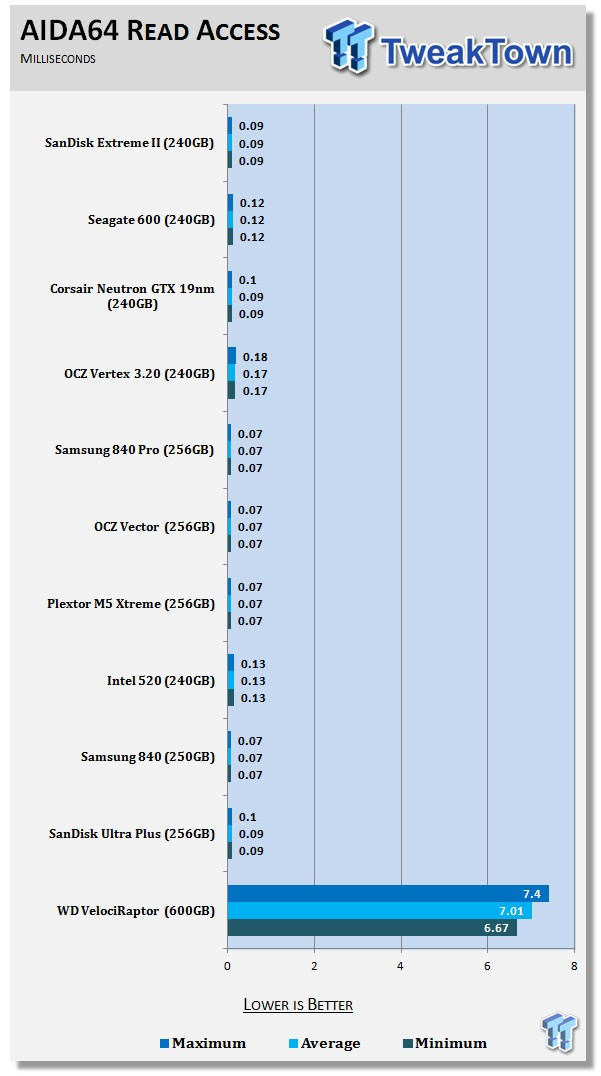
The read latency was steady in our AIDA64 test. We recorded .09ms and that amount is nearly equal to the 840 Pro and Vector.
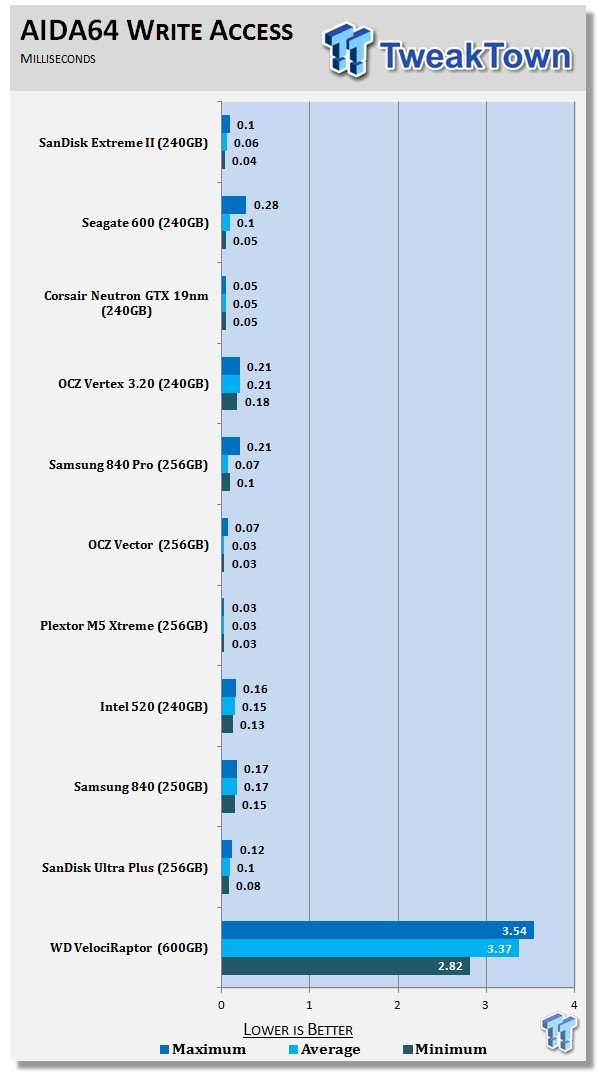
The write latency allowed us to see the cross over between the 1-bit write and 2-bit write, that's why the Extreme II shows a distinct .04 and .1ms difference between minimum and maximum latency.
Benchmarks - Anvil Storage Utilities
Anvil Storage Utilities
Version and / or Patch Used: RC6
So what is Anvil Storage Utilities? First of all, it's a storage benchmark for SSDs and HDDs where you can check and monitor your performance. The Standard Storage Benchmark performs a series of tests, you can run a full test or just the read or the write test or you can run a single test, i.e. 4K DQ16.
Anvil Storage Utilities is not officially available yet but we've been playing with the beta for several months now. The author, Anvil on several international forums has been updating the software steadily and is adding new features every couple of months.
The software is used several different ways and to show different aspects for each drive. We've chosen to use this software to show the performance of a drive with two different data sets. The first is with compressible data and the second data set is incompressible data. Several users have requested this data in our SSD reviews.
0-Fill Compressible Data
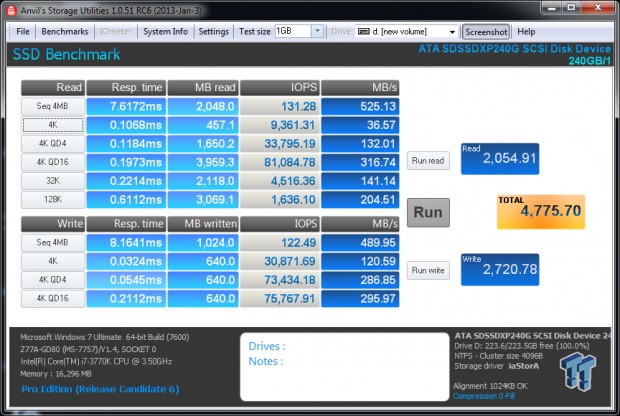
Incompressible Data
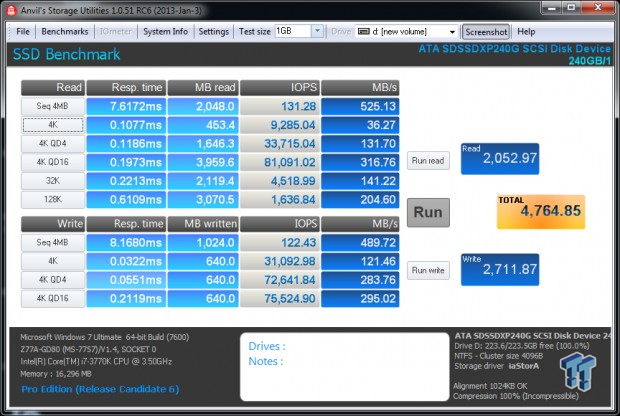
When comparing incompressible to compressible performance, we didn't notice a large difference moving between file types.
Read IOPS through Queue Depth Scale
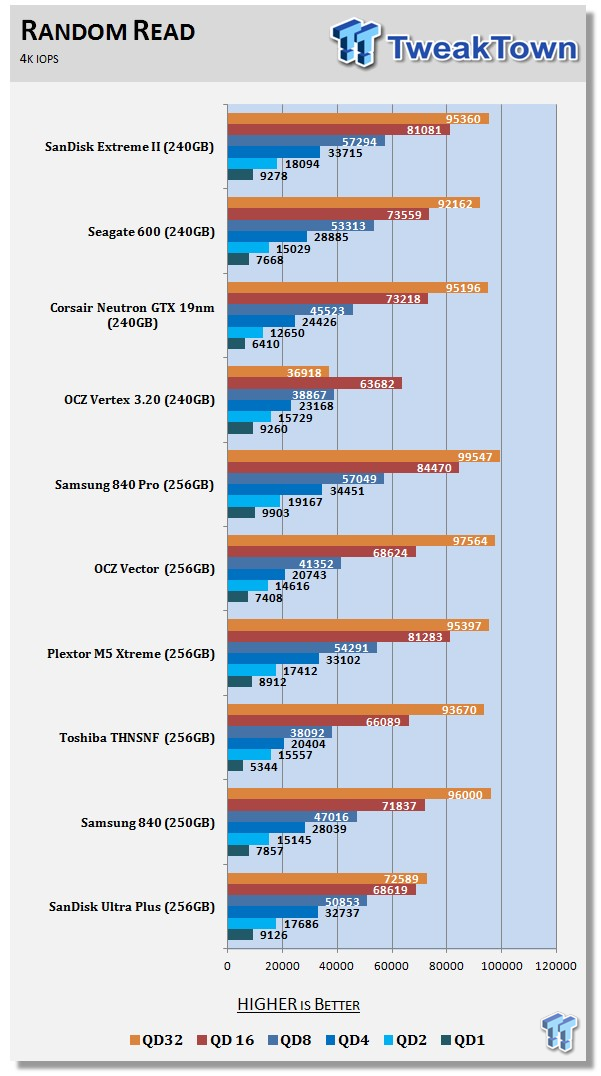
We're stirred the pot with our scaling IOPS tests - thanks for the feedback. Companies like to market their high queue depth IOPS performance, but under real-world use, desktop users will never get to a queue depth of 32.
Low queue depth IOPS give us a better understanding of how a SSD will perform in a consumer environment. The Extreme II sits right between 840 Pro and Vector at QD1 through QD4 reads.
Scaling Write IOPS through Queue Scale
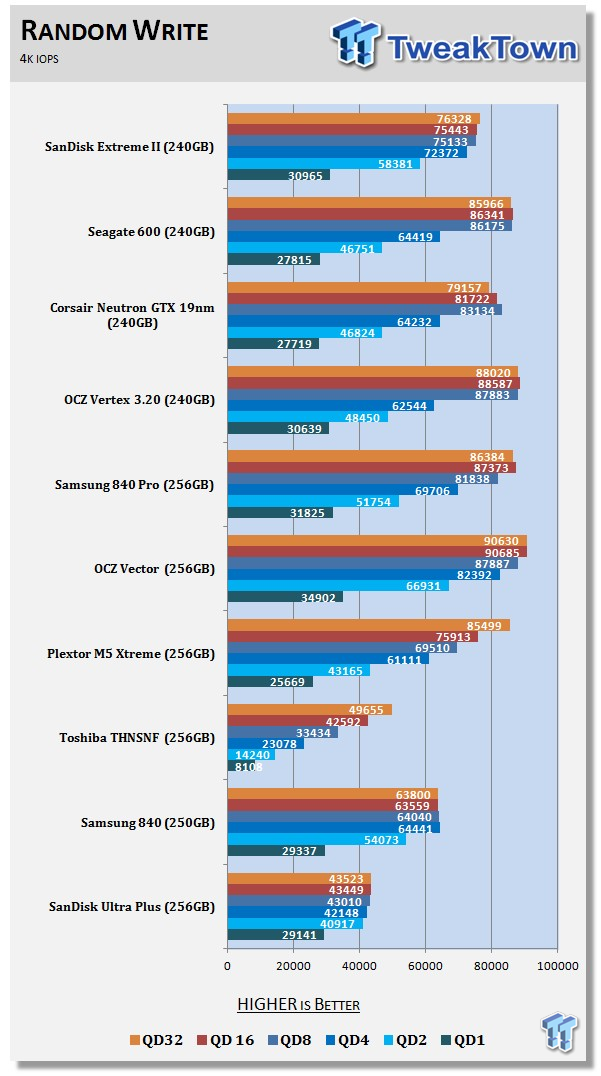
With 4K write IOPS, the Extreme II is behind both of the top tier drives in QD1.
Benchmarks - CrystalDiskMark
CrystalDiskMark
Version and / or Patch Used: 3.0 Technical Preview
Developer Homepage: http://crystalmark.info
Product Homepage: http://crystalmark.info/software/CrystalDiskMark/index-e.html
Download here: http://crystaldew.info/category/software/crystaldiskmark
CrystalDiskMark is a disk benchmark software that allows us to benchmark 4K and 4K queue depths with accuracy.
Key Features:-
* Sequential reads/writes
* Random 4KB/512KB reads/writes
* Text copy
* Change dialog design
* internationalization (i18n)
Note: Crystal Disk Mark 3.0 Technical Preview was used for these tests since it offers the ability to measure native command queuing at 4 and 32.
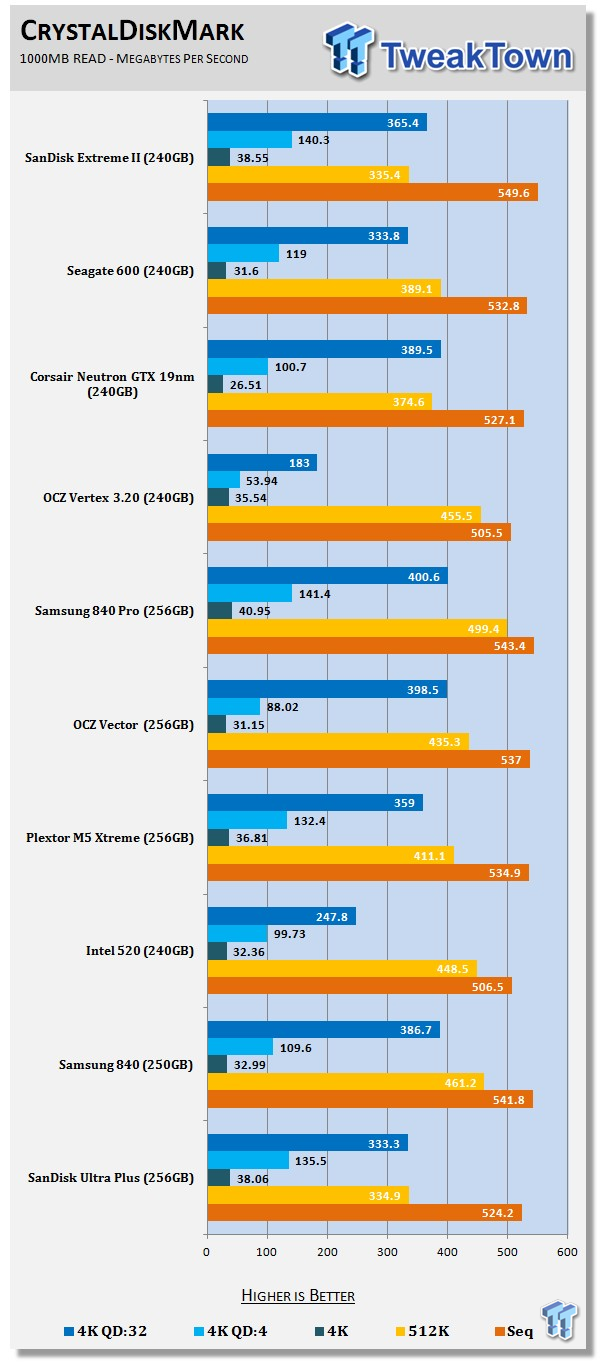
Looking at 4K performance through the throughput glasses, we see that Extreme II is so close to 40MB/s at QD1. With a little tuning, I bet SanDisk can break the 40MB/s mark in CDM's 4K read test. Extreme II scales really good with additional queue depth read requests.
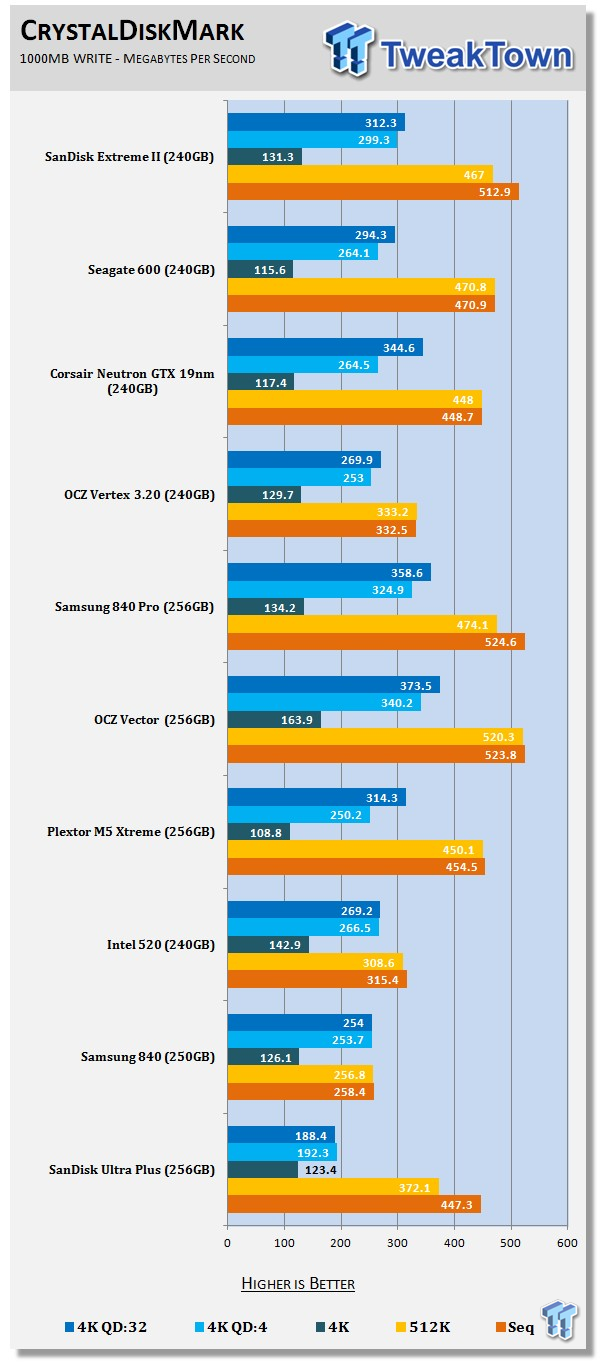
4K write performance scales well as the queue depth increases. Extreme II is still in running with the lead pack, but the results are not as impressive as the other two tier 1 SSDs.
Benchmarks - PCMark Vantage Hard Disk Tests
PCMark Vantage - Hard Disk Tests
Version and / or Patch Used: 1.0.0
Developer Homepage: http://www.futuremark.com
Product Homepage: http://www.futuremark.com/benchmarks/pcmark-vantage/

PCMark Vantage is the first objective hardware performance benchmark for PCs running 32 and 64 bit versions of Microsoft Windows Vista. PCMark Vantage is perfectly suited for benchmarking any type of Microsoft Windows Vista PC from multimedia home entertainment systems and laptops to dedicated workstations and high-end gaming rigs. Regardless of whether the benchmarker is an artist or an IT Professional, PCMark Vantage shows the user where their system soars or falls flat, and how to get the most performance possible out of their hardware. PCMark Vantage is easy enough for even the most casual enthusiast to use yet supports in-depth, professional industry grade testing.
FutureMark has developed a good set of hard disk tests for their PCMark Vantage Suite. Windows users can count on Vantage to show them how a drive will perform in normal day to day usage scenarios. For most users these are the tests that matter since many of the old hat ways to measure performance have become ineffective to measure true Windows performance.

HDD1 - Windows Defender
HDD2 - Gaming
HDD3 - Windows Photo Gallery
HDD4 - Vista Startup
HDD5 - Windows Movie Maker
HDD6 - Windows Media Center
HDD7 - Windows Media Player
HDD8 - Application Loading
The lower queue depth performance and sequential performance come together in Vantage to deliver very high yet balanced results in all tests.
Benchmarks - PCMark Vantage - Drives with Data Testing
For a complete breakdown on the Drives with Data Testing please read this article. You will be able to perform this test at home with the files provided in the article - full instructions are included.
- Brief Methodology
SSDs perform differently when used for a period of time and when data is already present on the drive. The purpose of the Drives with Data testing is to show how a drive performs in these 'dirty' states. SSDs also need time to recover, either with TRIM or onboard garbage collection methods.
Drives with Data Testing - 25%, 50%, 75% Full States and Dirty / Empty Test
Files needed for 60 (64GB), 120 (128GB), 240 (256GB)
60GB Fill - 15GB, 30GB, 45GB
120GB Fill - 30GB, 60GB, 90GB
240GB Fill - 60GB, 120GB, 160GB
Empty but Dirty - a test run just after the fill tests and shows if a drive needs time to recover or if performance is instantly restored.

The Samsung 840 Pro has higher 50% of capacity used performance in the 256GB class size, but Extreme II isn't too far behind. Extreme II also delivers a significant larger performance result over the SanDisk Ultra Plus 256GB, SanDisk's current mainstream SSD.
Benchmarks - BootRacer
BootRacer - System Boot Time
Version and / or Patch Used: 4.0
Developer Homepage: Greatis
Product Homepage: BootRacer
Download here: http://www.greatis.com/bootracer/download.htm
Note: In this test we use the Lenovo W530 Mobile Workstation loaded with an operating system and several program files. The data on the drive at the time of the test is 45GB. The second test, 50GB Free, was ran with the drives filled with block data until only 50GB of free capacity remained.
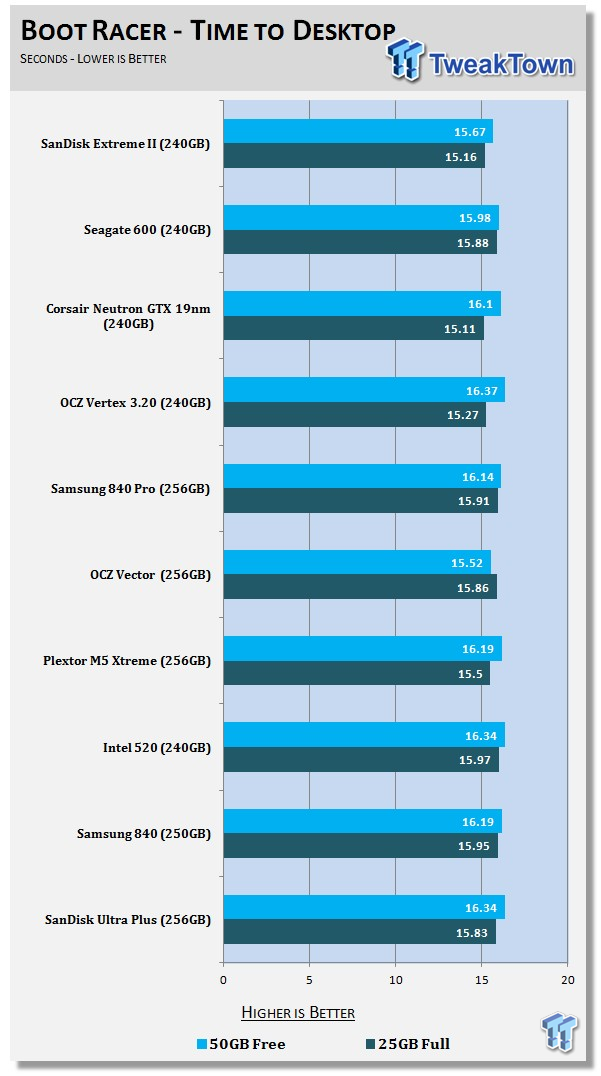
Our Lenovo W530 workstation isn't the fastest booting notebook on the market so nearly all of the performance SSDs in our chart produce roughly the same reboot results. It is nice to see how additional data on the flash affects performance in a real, real-world test.
Benchmarks - DiskBench
DiskBench - Directory Copy
Version and / or Patch Used: 2.6.2.0
Developer Homepage: Nodesoft
Product Homepage: DiskBench
Download here: http://www.nodesoft.com/diskbench/download
Note: In this test we use the Lenovo W530 Mobile Workstation and a SuperSSpeed S301 SLC 128GB SSD to move a 15GB block of data to and from the target drive. This is part of our real-world test regiment. Roughly 45GB of data resides on the target drive before the '15GB Block' is transfer. The 15GB Block is the same data we built for the Data on Disk Testing and is a mix of compressible and incompressible data.
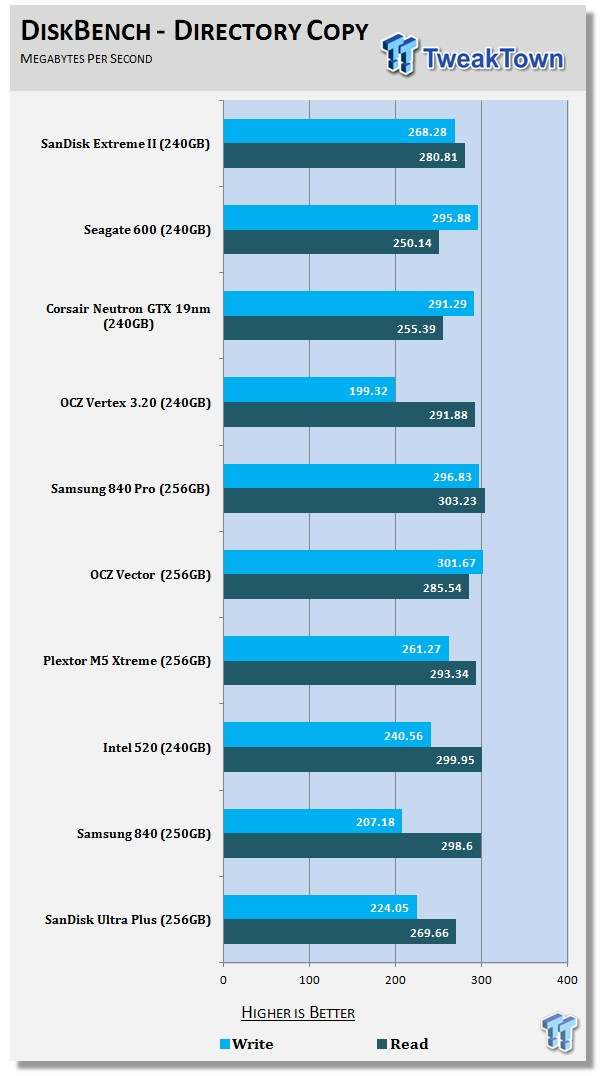
Just like the 120GB Extreme II, the 240GB model just doesn't quite get up to the same performance levels as 840 Pro and Vector when copying our mix data directory from one SSD to another. However, the data transfer performance is still very high.
On a 120GB or even a 240GB SSD, you won't transfer massive directories like this very often. Your usage model changes when you get into the 512GB class drives though since you have the spare area to shuffle massive volumes of data around.
Benchmarks - Power Testing
Bapco MobileMark 2012 1.5
Version and / or Patch Used: 2012 1.5
Developer Homepage: http://www.bapco.com
Test Homepage: http://www.bapco.com
MobileMark 2012 1.5 is an application-based benchmark that reflects usage patterns of business users in the areas of office productivity, media creation and media consumption. Unlike benchmarks that only measure battery life, MobileMark 2012 measures battery life and performance simultaneously, showing how well a system design addresses the inherent tradeoffs between performance and power management.
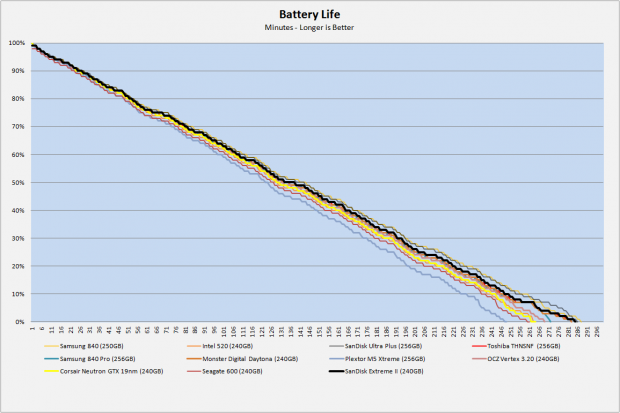
When I spoke with SanDisk, they really downplayed their power consumption for Extreme II. We've yet to get a LSI SandForce B02 stepping drive with 256GB of NAND, something I'm sure SanDisk has around the lab. Maybe that's why SanDisk didn't get out the pom-poms during our meeting.
As you can see here, the SanDisk Extreme II delivers very good battery life in our notebook test.
PCMark Vantage HDD Test - Power Draw
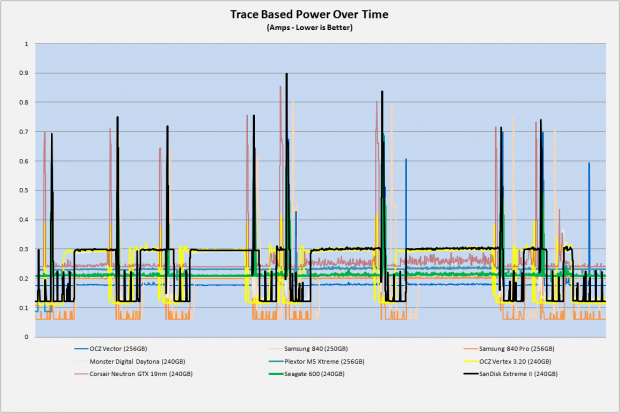
The Extreme II 240GB has fairly low idle power consumption, but at the same time produced very high random write power spikes. When reading data from the drive, the power shot up quite high as well.
Final Thoughts
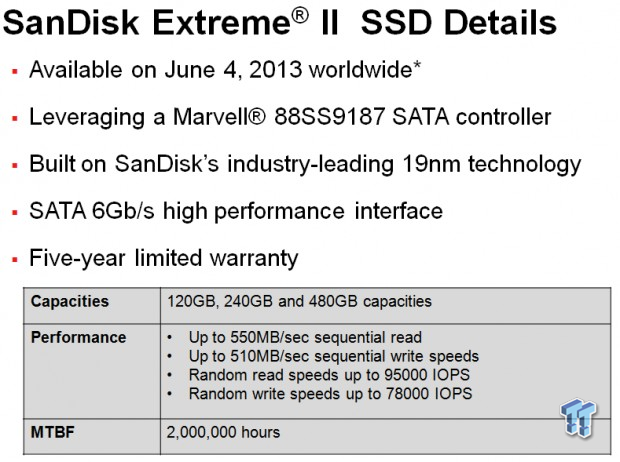
As we've mentioned a couple of times already today, the current products on the market aren't necessarily what we want to compare to SanDisk's Extreme II to, per se. Our charts are filled with several products using 24nm and 25nm flash. This flash is difficult to get now, so a large number of products on the charts simply won't be available soon. One of the products on the chart that is a competitor to Extreme II is Vector. OCZ tipped their hand a few days ago with the Vertex 450 release. A document we were allowed to publish shows Vector going EOL (End of Life) and Vector 150 taking its place. We haven't seen OCZ use Toggle flash since Vertex 3 Max IOPS, at least not on a consumer drive. If OCZ moves Vector 150 to 20nm, performance will suffer because IMFT 20nm isn't as flashy as 25nm (pun intended). Until we see it, we can only speculate, but right now we just know that one of the two drives that compete with Extreme II will roll off the market in the next three to four months.
The second drive that Extreme is trying to displace from the top of the performance tier is the Samsung 840 Pro. We've learned that Samsung will not have a major SSD announcement at Computex Taipei 2013, so 840 Pro will be around as their top tier offering at least till 3Q. With Lil' Kim taking pictures in front of his Pentium II rocket launcher, I can understand if Samsung is a little distracted. 840 Pro didn't hit the market until late in 2012, so there is no reason for us to think Samsung is off target.
The SanDisk Extreme II delivers equal performance to both of these products in the 256GB class size, but it manages to do it with less power consumption. For mobile users this is a big deal, desktop users not so much. Having used all three drives in the same notebook, I can say that the performance is nearly indistinguishable. I know not everyone is ready to go out and buy the fastest consumer SSD on the market, but they are damn fast. I really can't even imagine what the next level of performance would actually be because you don't wait on anything, as it is. You ask for something to happen and you get an immediate response. Can there even be something faster, than immediate? We are talking about computers so of course there will be, but right now, these three drives are the best we have. It's not a bad place to be especially when three will quickly go down to two.
SanDisk's MSRP for the 120GB Extreme II is $129.99, 240GB is $229.99 and the 480GB is $439.99. At the time of writing, OCZ's Vector 256GB was $30 more than Extreme II 240GB and Samsung's 840 Pro 256GB was $10 more. With all three drives producing nearly identical performance in this capacity size, I think everyone should pay close attention to the Extreme II. We all know MSRP are just suggestions and Newegg will lower the price within a month of launch. Could we see flagship SSD performance for $210 or maybe even $200? Oh I really hope so! Vector and 840 Pro have already shrank below their MSRP. In time, Extreme II will be the best choice for a hyper class SSD and at a good price.

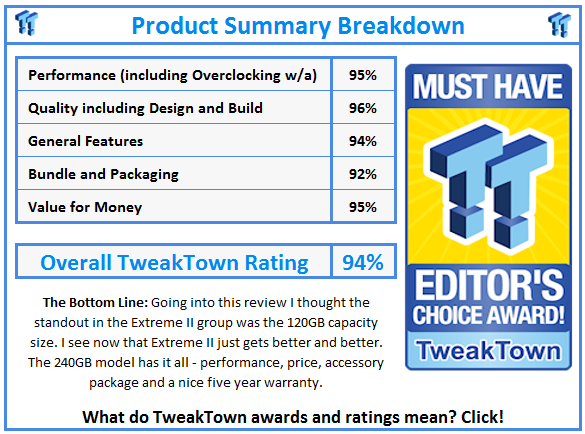
 United
States: Find other tech and computer products like this
over at
United
States: Find other tech and computer products like this
over at  United
Kingdom: Find other tech and computer products like this
over at
United
Kingdom: Find other tech and computer products like this
over at  Australia:
Find other tech and computer products like this over at
Australia:
Find other tech and computer products like this over at  Canada:
Find other tech and computer products like this over at
Canada:
Find other tech and computer products like this over at  Deutschland:
Finde andere Technik- und Computerprodukte wie dieses auf
Deutschland:
Finde andere Technik- und Computerprodukte wie dieses auf